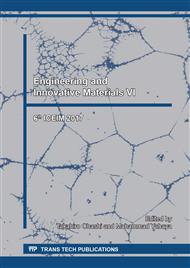p.38
p.44
p.53
p.58
p.63
p.68
p.73
p.80
p.89
Ultra-Fine and Nano-Crystalline Structure Induced by Sliding Friction of Carbon Steel
Abstract:
Sliding friction is one of the most powerful processes for microstructural evolution in the sub-surface, including grain refinement and recrystallization of deformed structure. Pin-on-disc sliding tests were carried out for 0.45 mass % carbon steels, and TEM microstructure and hardness of the specimens were investigated. Particularly effects of friction conditions on the microstructure at the surfaces and wear properties of the friction induced microstructure were studied. It was found that ultra-fine equi-axed grains in the 30 - 50 nm size range were produced in the case of a high friction speed of 5.0 m/s in an air atmosphere. Moreover, nano-crystalline microstructure can be produced in a vacuum atmosphere even if the friction speed was low. The friction induced nano-crystalline surface layers, which exhibited significant high hardness, showed good wear resistance.
Info:
Periodical:
Pages:
63-67
Citation:
Online since:
January 2018
Authors:
Price:
Сopyright:
© 2018 Trans Tech Publications Ltd. All Rights Reserved
Share:
Citation:


